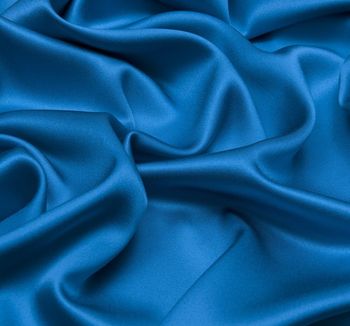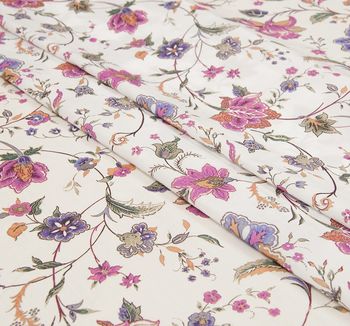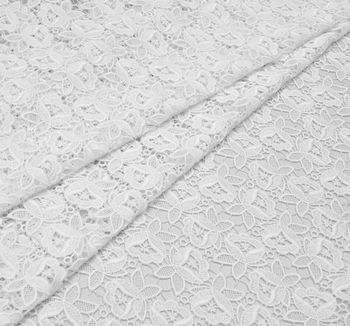Silk is a timelessly trendy natural fabric woven from the cocoons of silk worms. The world’s most famous fashion brands regularly apply it for various men’s and women’s outfits earning the admiration of the audience.
Shirting Fabric Guide
Shirting fabric is a kind of primarily cotton or cotton blend cloth used to make shirts. These fabrics should be breathable, durable, pleasant to the touch, and comfortable to wear all year round. That is why high thread count and yarn dyed structure are the essential features of shirting fabrics.
The popularity of shirts all around the globe has contributed greatly to the diversity of the fabrics they are made of: types of weave, fibre selection, design and pattern motifs. The variety of shirting fabrics is captivating. You can choose pure cotton, linen or man-made fibres, opt for finer or thicker options, go for vibrant or pastel shades, or try stripes, checks and florals. Shirting fabrics are used both for formal and casual wear.
Cotton or Linen?
According to the common belief, dress shirt fabrics are basically made of cotton. Why? Unlike many synthetics, cotton provides a plethora of valuable properties: this fibre is renowned for its softness, superb hygienic properties, and good moisture absorbency. However, in terms of fibre performance, its leadership is questionable — especially if compared with another fabric given to us by nature, which is linen. Cotton fabrics enjoy the highest popularity in the segment of formal shirts. At the same time, when it comes to casual style, linen appears to be a superior fibre by lots of important criteria.
First, linen has bactericidal properties which means it is not afraid of bacteria or fungus.
Second, linen garments are easier to care for. Unlike cotton, linen fibres get stronger and better cleanable with each washing. The best way to wash them is to select the gentle washing regime and lukewarm water temperature settings in your machine and use a mild detergent to make fibres less prone to damage. Linen fibre is twice as durable as cotton, and four times more durable than wool.
Third, linen is a 'greener' option. It requires much less water for growing, while its moisture absorbing capabilities are much higher compared to those of cotton, which means that you can wear linen garments for a longer time. Both points appear to be decent pros for all environmentally-conscious people.
As there is nothing ideal in this world, linen has a weakness too, which is its vulnerability to wrinkling. Apparently, that's one of the main reasons why linen is deemed to be a rather impractical match for a business suit. Another downside of linen is the thickness of its fibres: with the gain in durability, it gives way to cotton in terms of its hand feel, which is not that smooth.
All in all, both fabrics are breathable, hypoallergenic and have a good hand feel. Which one to choose then? It depends on your needs: for a business look, nothing can be compared with luxury long- and extra-long staple cotton fabrics of such precious sorts as Giza 45, Giza 87 and 88, Pima/Supima, and especially Sea Island. However, if a corporate dress code is not the limiting factor, a linen shirt is a way more promising option in many respects.

Single-ply or Double-ply?
The features mentioned above are desirable yet not essential. There are certain metrics that help us define whether this or that fabric meets our needs and expectations. One of the most important characteristics is single-ply or double-ply (a.k.a. '2-ply', ‘2-fold’, ‘2-twisted’ or ‘double-twisted’). What does it mean? ‘2-ply’ means the presence of two tightly twisted threads both in warp and weft, which endows it with four outstanding properties 1-ply fabrics lack.
- Double-ply fabrics are more durable.
- They can go through way more washings than single-ply fabrics.
- They are not prone to pilling.
- They have a smooth hand and a noble sheen.
Not all 2-ply fabrics are created equal. The higher-listed features are essential to the ‘2x2’ 2-ply fabrics having two threads both in warp and weft. In the ‘2x1’ and ‘1x2’ fabrics, the two threads are used in the warp and one in the weft, and vice versa. Obviously, when it comes to durability, the latter formula offers poorer characteristics.
In terms of the number of threads in warp or weft, the 2-ply is not the limit, as there are also 3-ply, 4-ply and 6-ply shirting fabrics. What you should take away, is that unlike the common logic, ‘more’ is not synonymic to ‘better’ in terms of the comfort of wear. The fabrics with 3 and more threads in warp and weft often appear to be too stiff and generally not that enjoyable for wearing. This rule is generally true for shirting fabrics, while the extra-fine suiting ones made of the 3-ply worsted wool gain a lot in terms of durability, yet still retaining its comfort in wearing.
Non-iron Properties
A shirt that doesn’t need to be ironed? Sounds like a miracle, isn’t it? Well, this is a double-edged sword: you save your time, but lose in something pretty much more important — your health. The trick of the ‘non-iron’ thing is in a special treatment of cloth with formaldehyde, which danger for a human organism doesn’t need to be explained much. Moreover, such fabrics don’t perform well in terms of durability and, which is even more frustrating, they still tend to wrinkle during washing and wearing. Not surprisingly, such controversial technology is generally utilized in the low-cost shirting fabric segment.
To be fair, some non-iron shirting fabric brands manage to go well without applying chemicals by treating their fabrics with natural-based elements that prevent wrinkling. Moreover, these textiles are also created of long-staple cotton fibres that meet the Oeko-Tex Standard 100 plus — the desirable mark of fabric safety for health. For such fabric production, a twisted thread with the fibre length of no less than 34 mm is used.
Thread Count
Just like in case of wool fabrics, shirting ones are measured by fineness too. This criterion is the ratio between fabric smoothness and durability: as the super number increases, the fabric becomes smoother yet more prone to occasional tearing. The range varies from Super 50's to Super 330's. The thread count above Super 100's is the feature of 2-ply fabrics only, which means that two Super 50's (or higher) yarns are intertwisted to make a single thicker thread.
According to experts, the most optimal shirting is from Super 60's to Super 80's. Such fabrics tend to wrinkle less than higher super numbers, and still remain very strong.

Weave Types
How is your fabric woven? We probably don’t pay much attention to this matter, however, the weave type does influence our perception of shirting fabric.
|
weave type |
weave description |
application |
|
poplin |
A plain weave (the threads alternately cross over and then under each other, with a vague striped appearance). Strong, durable, and smooth |
Formal dress code, daily business look, special occasions |
|
zephyr |
Its square construction, made with an almost equal number of threads per centimetre in warp and weft, results in airiness and exceptional breathability |
Daily business look, free time |
|
oxford (a.k.a. ‘panama’) |
Numerous warp threads cross over an equal number of weft threads, forming a basket weave. Its distinction from a plain weave is in thicker yarns resulting in a rough texture and high durability |
Free time (in the EU), daily business look (in the U.S.) |
|
pinpoint |
A sort of the oxford weave: it creates a fairly grainy fabric with a weft that appears to be made by an infinite number of pinpoints |
Formal |
|
twill |
The weave creates a diagonal texture: a weft thread runs over and under multiple warp threads |
Formal, business trips |
|
piquet |
The classic wavy effect of piquet is created by warp threads with a higher tension lowering the weft threads |
Formal, daily business look code |
|
fil a fil (a.k.a ‘end-on-end’) |
Plain weave type comprising the pair of light and dark threads in warp and weft to create a so-called ‘heathered effect’ |
Daily business look, free time |
|
dobby |
Delicate dotted or striped patterns featuring the same colours as the base material |
Daily business look, special occasions |
|
jacquard |
Jacquard weave with the application of a specific loom designed to produce patterned fabrics. |
Casual, free time |
How to Select?
After reviewing the key characteristics of shirting fabrics, it’s time to make a shortlist of parameters one should pay attention:
Seek for 2-ply fabrics with 2 threads in the warp and weft (2x2) to ensure decent fabric strength.
Unless you expect business trips, don’t make the ‘non-iron’ feature your first priority, as there’s a certain risk to buy a chemically treated fabric. Go for the fabrics with an ‘easy iron’ tag instead. With a certain increase in price, you will stay confident your shirt won’t cause you allergic reactions.
In terms of fabric fineness, go for the range between Super 60’s and Super 80’s.
While the weave type is basically the matter of taste, you should better stick to the one that fits you most. Beware of jacquard or oxford weaves, they are not the best picks in case of white-collar job dress code!
.jpg)
Tissura Collection
Tissura offers an extensive selection of shirting fabrics by the leading cotton manufacturers from Italy and Switzerland:
- Cotonificio Albini
- Thomas Mason
- Hausammann
At Tissura, you always buy online shirting fabrics from the latest collections, as we regularly update our range when the manufacturer launches a new fabric design. Such close connections with suppliers are our matter of particular pride, however, when it comes to the fabrics for the garments that take their decent place in your daily business wardrobe, the factors of pleasant tactile feel and durability become truly cornerstone ones. That is why we gladly present fabrics woven of long staple cotton that guarantees that precious combo of softness and durability.
Below, we have picked some classy cotton shirting fabrics to make a general impression of our range. To enjoy our entire collection, click on the blue button below.
Cotton shirting fabric, 28 € (34 US$) per one running metre;
Cotton shirting fabric, 35 € (43 US$) per one running metre;
Cotton shirting fabric, 69 € (84 US$) per one running metre;
Cotton shirting fabric, 47 € (57 US$) per one running metre
How to stay cool on a hot summer day? Wear fabrics built for the heat. Cotton, linen, viscose, silk – there are dozens of summer-friendly materials you can choose for your wardrobe. The best fabric to opt for when the temperature rises should be breathable and comfortable.
The wedding dress is one of the most important clothing items a woman gets to choose in her lifetime. It can be made of silk or cotton, lace or tulle, be strewn with sequins or embroidered with beads.
.jpg)
.jpg)
.jpg)
.jpg)
.jpg)


